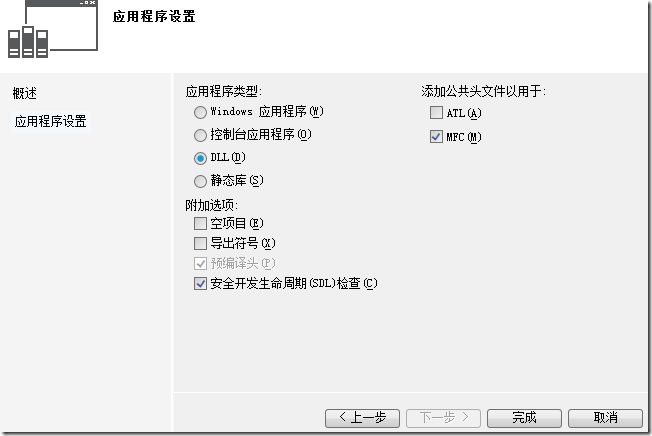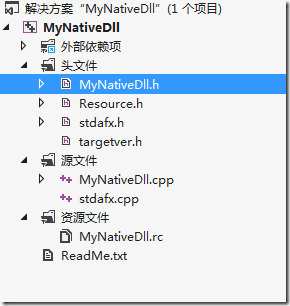C#与C/C++相比,前者的优势在于UI,后者的优势在于算法,C++下的指针虽然恶心,若使用得当还是相当方便的,最重要的问题是,市面上很多流行的开发工具库,几乎没有不支持C++的,但全面支持C#只能说是难得。在CPU发展到今天,若说C#的执行效率跟C++相比有很大的差距,并不是那么靠谱,若非万不得已我还是宁愿用C#来写代码,调试什么的也很方便。
不得已的情况下,要在C#下使用C++的函数或类,最好的方式就是使用动态链接库(dll),至于COM什么的我是至今没弄明白其原理,也许主要是因为使用起来太麻烦了(还要注册什么的),使用dll的话,可以很方便将一个工程细分到成为两部分,协同编程可以加速进展。当然,用C#的代码改写一遍也不是不可能的,可当你有现成的几万行代码需要重写,那就真头痛得要命,还是安心的使用动态链接库吧。
要使用非托管的C++代码有两种形式:导入非托管C++的函数和导入非托管C++的类。下面先说一下第一种:导入非托管C++代码的函数:
(1)建立生成dll的工程
我用的是VS2012,不过好像跟前面的版本没什么太大的差别。打开VS,选择"新建项目"----“Visual C++”----"Win32"----"Win32项目",工程的名字叫"MyNativeDll",配置如下图所示,因为我有可能用到MFC的类,所以我就勾选了“MFC”的选项。在此需要注意的是,如果你新建时没有勾选MFC,但在后面却想动用MFC的内容,就会遇到“MFC apps must not #include ”的Error,但是在工程的配置里修改是根本没有用的,必做要重建工程。
注意到上图中的预编译头文件的复选框是默认的,具体的内容参见:
(2)实现dll导出的函数
新建好工程后,在VS的“解决方案资源管理器”中可以看到如下图的目录,其实你完全可以不用管这些默认的文件,如果你要用,可以在看一下MyNativeDll.h里的注释说明,大概能看得懂的。
在工程里添加几个文件,Define.h,CFunction.h,CFunction.cpp,其内容如下所示:
//Define.h 用于导入dll的宏定义。
//Define.h /////////////////////////////////////////// ////////////////////////////////////////// #ifndef _DEFINE_H_ #define _DEFINE_H_ #define _EXTERN_C_ extern "C" _declspec(dllexport) #endif
__declspec(dllexport) extern “C”
__declspec(dllexport)将一个函数声明为导出函数,就是说这个函数将被包含它的程序之外的函数调用。
extern “C”使得在C++中使用C编译方式成为可能,在C++下定义C函数需要加extern “C”关键词。使用extern “C”来指明该函数使用C编译方式。这样一来输出的函数就可以从C代码里调用了。
cpp文件在编译为obj文件时,要对函数进行重命名,C语言会把函数name重命名为_name,而C++会重命名为_name@@decoration。
extern “C”指示编译器用C语言的方法给函数重命名。
在制作DLL导出函数的时候,由于C++存在函数重载,因此__declspec(dllexport) function(int ,int)在DLL中会被decorate。例如被decorate成function_int_int,而且不同的编译器decorate的方法不同,造成了在用GetProcAddress取得function地址时,找不到DLL中函数的地址。在使用extern “C”时,上面说的decorate就不会再发生了,这样就能很容易的找到要调用的函数的地址。也正是因为没有了decorate,所有C编译方式没有函数重载,但是如此一来,被extern “C”修饰的函数,就不具备了重载的能力。所以extern和extern “C”不是一回事。
//CFunction.h 函数声明,这里我特意声明了一组结构,我的用意稍后再讲。
//CFunction.h //////////////////////////////////////////// /////////////////////////////////////////// #ifndef _C_FUNCTION_H_ #define _C_FUNCTION_H_ #include "Define.h" #include <string> #include <istream> struct SystemTime { int year; int month; int day; int hour; int minute; int second; int millsecond; SystemTime & operator= (SystemTime st) { this->year = st.year; this->month = st.month; this->day = st.day; this->hour = st.hour; this->minute = st.minute; this->second = st.second; this->millsecond = st.millsecond; return *this; } }; _EXTERN_C_ int add(int x, int y); _EXTERN_C_ int sub(int x, int y); _EXTERN_C_ int testChar(char * src, char * res, int nCount); _EXTERN_C_ int testStruct(SystemTime & stSrc, SystemTime & stRes); #endif //_C_FUNCTION_H_</istream></string>
//CFunction.cpp dll函数的实现,简单的赋值而已,大家应该看得明白的。
//CFunction.cpp //////////////////////////////////////////// //////////////////////////////////////////// #include "stdafx.h" #include "CFunction.h" #include <stdio.h> int add(int x, int y) { return x + y; } int sub(int x, int y) { return x - y; } int testChar(char * src, char * res, int nCount) { memcpy(res, src, sizeof(char) * nCount); return 1; } int testStruct(SystemTime & stSrc, SystemTime & stRes) { stRes = stSrc; return 1; }
添加好代码之后,选择“生成”的选项,因在解决方案目录下的Debug文件就已经存在我们所需要的MyNativeDll.dll文件,一起的还有lib的静态库文件(稍后要用到),及其他相关的调试文件,至此,我们已经成功的生成了native C++的动态链接库,我只能说,这是相当简单的第一步在而已。(native C++就是非托管的C++)
(3)在C#工程下使用生成的dll
新建一个C#的窗口工程,工程命名为“DllTest”。
在新建的窗体工程中添加一个CFunction.cs的类,这个类主要是用于导出上面dll里的函数,废话不多说,直接贴代码:
//CFunction.cs dll的函数接口
using System; using System.Collections.Generic; using System.Linq; using System.Text; using System.Threading.Tasks; using System.Runtime.InteropServices; namespace DllTest { [StructLayout(LayoutKind.Sequential)] public struct SystemTime { public int year; public int month; public int day; public int hour; public int minute; public int second; public int millsecond; public SystemTime(DateTime dt) { this.year = dt.Year; this.month = dt.Month; this.day = dt.Day; this.hour = dt.Hour; this.minute = dt.Minute; this.second = dt.Second; this.millsecond = dt.Millisecond; } public override string ToString() { return this.year.ToString() + "-" + this.month.ToString() + "-" + this.day.ToString() + " " + this.hour.ToString() + ":" + this.minute.ToString() + "-" + this.second.ToString() + "-" + this.millsecond.ToString(); } }; public class CFunction { [DllImport("MyNativeDll.dll", CharSet = CharSet.Auto, CallingConvention = CallingConvention.Cdecl)] public extern static int add(int x, int y); [DllImport("MyNativeDll.dll", CharSet = CharSet.Auto, CallingConvention = CallingConvention.Cdecl)] public extern static int sub(int x, int y); [DllImport("MyNativeDll.dll", CharSet = CharSet.Auto, CallingConvention = CallingConvention.Cdecl)] public extern static int testChar(ref byte src, ref byte res, int nCount); [DllImport("MyNativeDll.dll", CharSet = CharSet.Auto, CallingConvention = CallingConvention.Cdecl)] public extern static int testStruct(ref SystemTime stSrc, ref SystemTime stRes); } }
上面的做法相当是作了一个CFunction的静态类而已。然后在Form1.cs窗体里直接写测试代码,我就直接写在Form1的初始化函数里,简单展示一下成功调用:
//Form1.cs 在C#的窗体初始化函数添加测试代码:
using System; using System.Collections.Generic; using System.ComponentModel; using System.Data; using System.Drawing; using System.Linq; using System.Text; using System.Threading.Tasks; using System.Windows.Forms; using System.Diagnostics; namespace DllTest { public partial class Form1 : Form { public Form1() { InitializeComponent(); int a = CFunction.add(100, 50); int b = CFunction.sub(100, 50); Debug.WriteLine("add = " + a.ToString() + " b = " + b.ToString()); Debug.WriteLine(" "); string src = "123456"; byte[] srcBytes = System.Text.Encoding.ASCII.GetBytes(src); byte[] resBytes = new byte[100]; a = CFunction.testChar(ref srcBytes[0], ref resBytes[0], src.Length); string res = (System.Text.Encoding.ASCII.GetString(resBytes, 0, resBytes.Length)).TrimEnd(); Debug.WriteLine(res.ToString()); Debug.WriteLine(" "); SystemTime stSrc = new SystemTime(DateTime.Now); SystemTime stRes = new SystemTime(); a = CFunction.testStruct(ref stSrc, ref stRes); Debug.WriteLine(stRes.ToString()); Debug.WriteLine(" "); } } }
在你进行调试之前,务必记得要将在第二步生成的MyNativeDll.dll拷贝至C#工程下的binDebug目录下,然后点击“调试”,看输出窗口,应该会有东西输出的。
(4)总结
1)总体上来讲,生成一个native C++的dll不是很困难的事,重点在于在C#下的dll导出函数那里;
2)个人的经验来看,使用native C++可以导入函数,至于导出C++类,通过指针的方式并非不可能,可是方法过于费解,建议不要那么做,下篇讲导出C++类的方法;
3)在书写dll导出函数时,变量的传递是关键,建议使用C++的基本类型,如int,float,double等,因为C#下指针的概念很纠结,在C++下的引用符“&”,在C#中则使用ref的标识,需要紧记的一点是,C#与C++的类型并不全然通用(结构对齐问题),注意做变换。像上面的testChar函数,原本string(C#)对应的是char*(C++),但可能由于各种Unicode或多字节的关系,我是没法返回正确的值,于是我采用了byte的传入类型。
4)观察我写的结构,在C++下使用的结构体,在C#必须要重新定义一次,使用 [StructLayout(LayoutKind.Sequential)]的标识用于结构的对齐,如果你变量中使用了string这样的类型,还需要使用MarshalAs这样的方法支定义其长度——才可以跟char *相对应;
5)函数的返回值别用什么string了,我是找为到方法取得其正确的返回值,最好使用ref的引用方法回传回来。
6)指针的参数的传递在C#下使用IntPtr类型作转换,这我先不细说,网上相关文章还是不少的。

